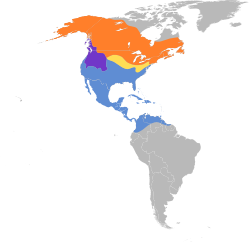| Wilson's snipe | |
|---|---|
 | |
| Scientific classification | |
| Kingdom: | Animalia |
| Phylum: | Chordata |
| Class: | Aves |
| Order: | Charadriiformes |
| Family: | Scolopacidae |
| Genus: | Gallinago |
| Species: | G. delicata |
| Binomial name | |
| Gallinago delicata (Ord, 1825) | |
 | |
| Synonyms | |
Gallinago gallinago delicataOrd, 1825 | |
Wilson's snipe (Gallinago delicata) is a small, stocky shorebird. [2] The generic name Gallinago is Neo-Latin for a woodcock or snipe from Latin gallina, "hen" and the suffix -ago, "resembling". The specific name delicata is Latin for "dainty". [3]
Contents
- Description
- Breeding and habits
- Population
- References
- Further reading
- Identification
- European occurrences
- External links
This species was considered to be a subspecies of the common snipe (G. gallinago) until 2003 when it was given its own species status, though not all authorities recognized this immediately. [4] Wilson's snipe differs from the latter species in having a narrower white trailing edge to the wings, and eight pairs of tail feathers instead of the typical seven of the common snipe. [5] Its common name commemorates the American ornithologist Alexander Wilson.

